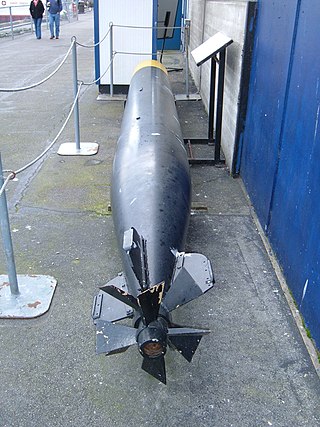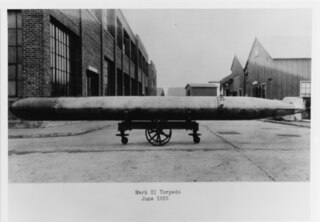Related Research Articles

A modern torpedo is an underwater ranged weapon launched above or below the water surface, self-propelled towards a target, and with an explosive warhead designed to detonate either on contact with or in proximity to the target. Historically, such a device was called an automotive, automobile, locomotive, or fish torpedo; colloquially a fish. The term torpedo originally applied to a variety of devices, most of which would today be called mines. From about 1900, torpedo has been used strictly to designate a self-propelled underwater explosive device.

A PT boat was a motor torpedo boat used by the United States Navy in World War II. It was small, fast, and inexpensive to build, valued for its maneuverability and speed but hampered at the beginning of the war by ineffective torpedoes, limited armament, and comparatively fragile construction that limited some of the variants to coastal waters. In the US Navy they were organized in Motor Torpedo Boat Squadrons (MTBRONs).

A motor torpedo boat is a fast torpedo boat, especially of the mid 20th century. The motor in the designation originally referred to their use of petrol engines, typically marinised aircraft engines or their derivatives, which distinguished them from other naval craft of the era, including other torpedo boats, that used steam turbines or reciprocating steam engines. Later, diesel-powered torpedo boats appeared, in turn or retroactively referred to as "motor torpedo boats" for their internal combustion engines, as distinct from steam powered reciprocating or turbine propulsion.

The Type 95 torpedo was a torpedo used by submarines of the Imperial Japanese Navy during World War II.

The Mark 13 torpedo was the U.S. Navy's most common aerial torpedo of World War II. It was the first American torpedo to be originally designed for launching from aircraft only. They were also used on PT boats.
The Admiral-class battlecruisers were to have been a class of four British Royal Navy battlecruisers built near the end of World War I. Their design began as an improved version of the Queen Elizabeth-class battleships, but it was recast as a battlecruiser after Admiral John Jellicoe, commander of the Grand Fleet, pointed out that there was no real need for more battleships, but that a number of German battlecruisers had been laid down that were superior to the bulk of the Grand Fleet's battlecruisers and the design was revised to counter these. The class was to have consisted of HMS Hood, Anson, Howe, and Rodney — all names of famous admirals — but the other three ships were suspended as the material and labour required to complete them was needed for higher-priority merchantmen and escort vessels. Their designs were updated to incorporate the lessons from the Battle of Jutland, but the Admiralty eventually decided that it was better to begin again with a clean-slate design so they were cancelled in 1919. No more battlecruisers would be built due to the arms limitations agreements of the interbellum.

The Mark 24 mine is an air-dropped anti-submarine (ASW) acoustic torpedo developed by the United States during World War II; it was called a mine to conceal its capabilities. The torpedo entered service with the Allies in March 1943; the United States Navy (USN) used it until 1948. Approximately 4,000 were produced. Of the 340 deployed during the war, 204 were fired, sinking 37 and damaging 18 Axis submarines.

The Mark 37 torpedo is a torpedo with electrical propulsion, developed for the US Navy after World War II. It entered service with the US Navy in the early 1950s, with over 3,300 produced. It was phased out of service with the US Navy during the 1970s, and the stockpiles were sold to foreign navies.

The J, K and N class consisted of 24 destroyers built for the Royal Navy beginning in 1938. They were a return to a smaller vessel, with a heavier torpedo armament, after the Tribal class that emphasised guns over torpedoes. The ships were built in three flotillas or groups, each consisting of eight ships with names beginning with "J", "K" and "N". The flag superior of the pennant numbers changed from "F" to "G" in 1940.

An aerial torpedo is a torpedo launched from a torpedo bomber aircraft into the water, after which the weapon propels itself to the target.

The Mark 14 torpedo was the United States Navy's standard submarine-launched anti-ship torpedo of World War II. This weapon was plagued with many problems which crippled its performance early in the war. It was supplemented by the Mark 18 electric torpedo in the last two years of the war. From December 1941 to November 1943 the Mark 14 and the destroyer-launched Mark 15 torpedo had numerous technical problems that took almost two years to fix. After the fixes, the Mark 14 played a major role in the devastating blow U.S. Navy submarines dealt to the Japanese naval and merchant marine forces during the Pacific War.

The Mark 34 torpedo was a United States torpedo developed that entered service in 1948. It was an improved version of the Mark 24 FIDO passive acoustic homing torpedo developed during World War II for launch from fixed-wing aircraft. The principal differences from the Mark 24 were the use of two propulsion batteries, which could be used in parallel while the torpedo was searching for a target to provide greater endurance and in series to provide greater speed in attack mode.

The Myōkō-class cruisers were a series of four heavy cruisers built for the Imperial Japanese Navy in the late 1920s. Three were lost during World War II.
There have been a number of 18-inch (45cm) torpedoes in service with the Royal Navy of the United Kingdom.
There have been a number of 21-inch (53.3cm) torpedoes in service with the Royal Navy of the United Kingdom.

The Dealey-class destroyer escorts were the first post-World War II escort ships built for the United States Navy.
The Whitehead Mark 5 torpedo was a Whitehead torpedo adopted by the United States Navy for use in an anti-surface ship role in 1910. The Mark 5 was the first torpedo to be manufactured by a foreign company, the Whitehead facility in the United Kingdom, and in 1908, by the Naval Torpedo Station in Newport, Rhode Island. It was also the first torpedo to allow the firing ship to vary the torpedo's speed and range.

The Mark 11 torpedo was the first American torpedo to be designed within the United States Navy without collaboration from industry. It was developed by the Washington Navy Yard in Washington, D.C., and the Naval Torpedo Station in Newport, Rhode Island. The Mark 11 torpedo was also the first to feature a three-speed setting capability while tube-loaded: high at 46 knots, medium at 34 knots and low at 27 knots. Due to stability problems it was supplemented by the Mark 12 torpedo within two years, which had a 44-knot high speed setting.